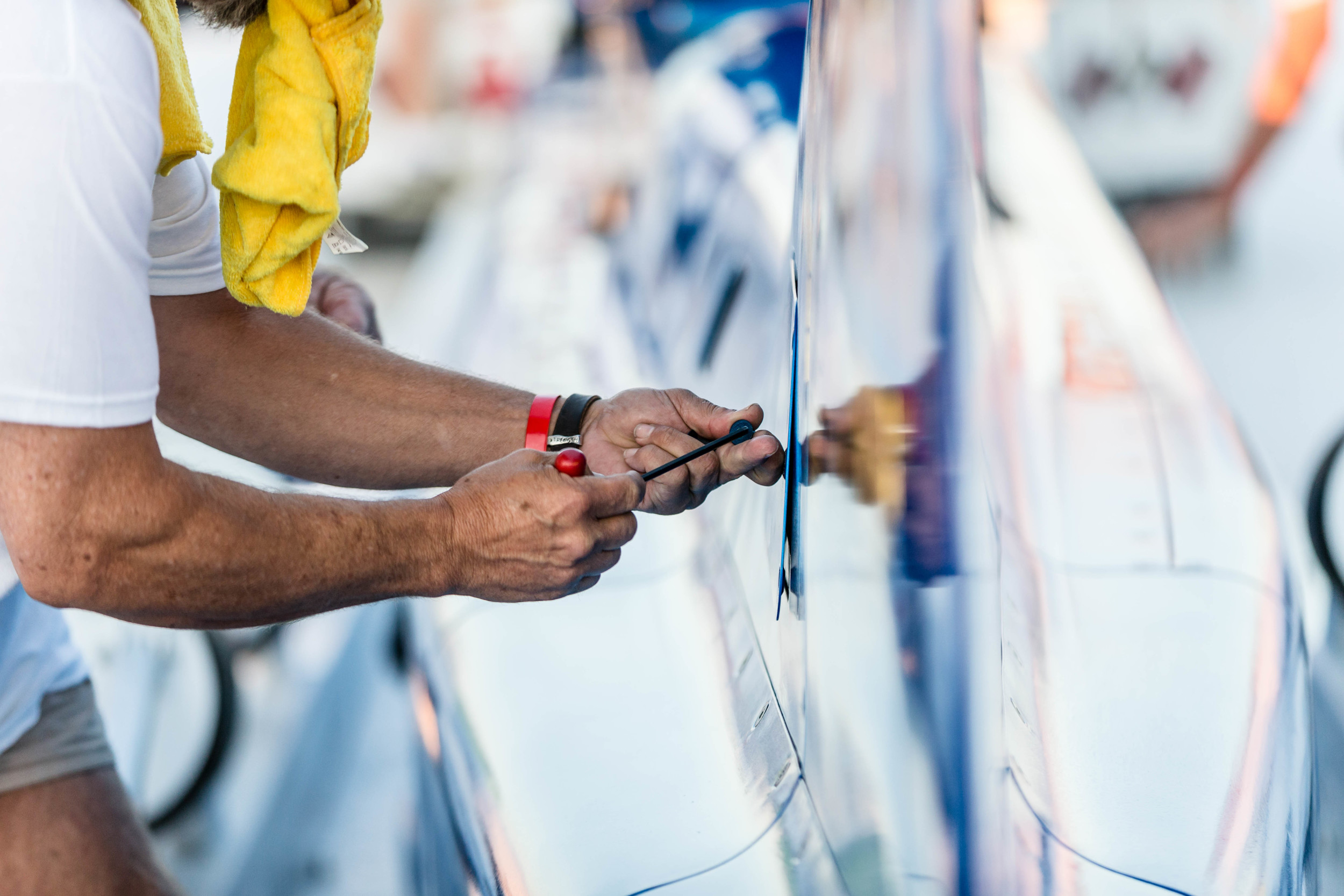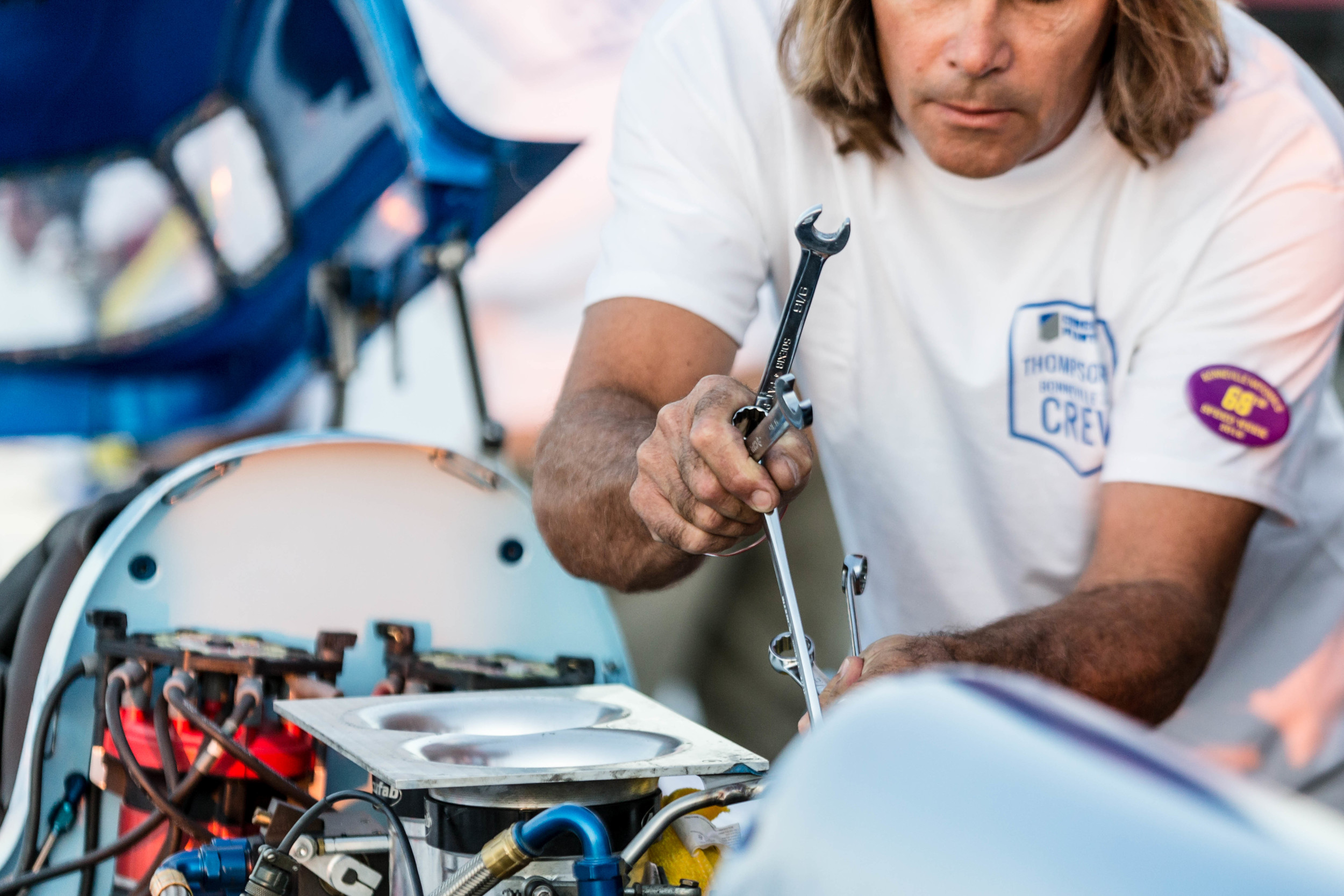We’re eighteen days away from Speed Week. Given that its been 587 days since the Challenger 2 was last on the salt, that doesn’t seem like a very long time at all. One major difference this season is that we’re no longer based in Huntington Beach. Valerie and I moved back to our home in Colorado last year, and of course we brought the streamliner with us. I tried to bring the crew along as well, but there wasn’t enough room in the barn, and VT thought some of the boys might scare the horses. So instead we’re having to coordinate with everyone remotely.
The Challenger 2 project is a predominantly volunteer operation, but it’s just as complex as any other large racing program. Between the engine crew, the mechanics, the fuel team, and all of the support personnel, we’ll have 25 people coming to Bonneville with us this year as members of Thompsonlsr. I’m very grateful to the crew for their support, and I wanted to write a brief post about them prior to out departure. Here’s a quick look at this year’s team, presented below in alphabetical order.
Lou “Dog” Anderson
Lou is a top notch fabricator and will be our car chief for Speed Week. He was one of my original full time guys and is responsible for a lot of the upgrades to the Challenger 2.
Larry Baird
Larry is our CAD wizard and general computing expert. Before anyone else started working on the project, Larry was drafting the intake manifolds, axels, and a bunch of the other mechanical stuff I needed to get things started. He’s also a professor at GWC in Orange County in case you feel like failing a class.
Warren Baird
Warren is a Baja 1000 winning off-road mechanic and co-driver. He built my first Chevrolet stadium truck and will be handling far-end support for us. He owns a company called Precision Four-Wheel Drive up in Fresno.
Danny Bern
Danny is helping us set up the pits this year. He’s also in charge of my air and breathing systems. He’s an underwater diving and SCUBA gear supplier and can often be found in Mexico, making sure people make it back up from beneath the waves.
Cherico Brown
Cherico is my niece and will be running the hospitality operation for us. I think people often underestimate how important keeping everyone well fed, well hydrated, and generally as happy as possible is to team cohesion, and she does a great job of that out on the salt.
Jason Brown
Jason is Cherico’s husband, and will be our pit captain, as well as the head honcho of radios and communication. He’s an electrical expert that works for Prevost, and in addition to all of his pit duties he helped us rewire the Challenger’s trailer last year. It works now—a major improvement.
Richard “RC” Catton
RC, along with Craig, is our main engine guy. His shop, RC Performance, is based in Huntington Beach, and he’s involved in everything from hot rods to sprint cars to fuel engine and drag racing. His work is immaculate and his engines perform fantastically.
Jerry Darien
Jerry’s background is A-fuel dragsters, and he came up with our dry block engine combination. He runs an NHRA racing team and is responsible for training the daughters of John Force as well as a whole lot of other top notch drivers.
Tim Gibson
Tim is our team engineer. He’s handled everything from vehicle aerodynamics to redesigning the front end steering system. Tim has an intimate understanding of all aspects of the car and has been an integral part of almost all our updates. A former top fuel driver, he’s worked for Dan Gurney, John Force, Kenny Bernstein and many other leading lights of the industry.
Dave Hadley
Dave is a master machinist and engineer, as well as the namesake behind our notoriously tricky Hadley Box system. All the gorgeous billet work on the C2? That’s Dave. Whatever Gibson could design, he could build. A long time supporter of the project and a good friend.
Frank Hanrahan
Frank was my first full-time hire and has been with the project for more than three years. A fantastic fabricator and former sprint car driver, he can build anything you throw at him and his hands are behind many aspects of the rebuild.
Terry Hegman
Terry is a virtuoso metal shaper and hot rod builder. His beautiful Mercury was recently featured on the cover of Rodder’s Journal. He’s an old school talent, and is responsible for all of the hand formed additions to the Challenger 2’s external aluminum skin.
Eric Hoeing
Eric is our main man. He’s handling fuel and logistics for us this year, as well as anything else we can think to throw at him. He's a former Indianapolis guy who now builds hod rods and concrete plants up in New York.
Matt Holmes
Matt is our all-around-guy on the salt. He sculpted the C2’s new nose for us last year. He’s an artist, modeler, and mold maker at The Disney Company.
Craig Johnson
Craig is in charge of the front engine, and along with RC is responsible for the engine package as a whole. He’s been the lead engine builder at Shaver for many years, and is responsible for all of Tony Stewart’s sprint car engines in addition to a gallery of other fire-spitting performance monsters.
Rich Kurtz
Rich is our bottom end engine guy. He’s the one under the car between runs dodging drops of boiling oil. He works with Catton and has a background in drag racing and funny cars.
Ray Lara
Ray’s been with me from the beginning. 45 years of dealing with my nonsense—I should probably give him a medal. He’s a friend, a mechanic, and will also be in charge of our team’s security this year.
Ron Martin
Ron’s Mr. Super-Enthusiastic. He’ll be helping out with our pit operations and anything else we throw at him. When he’s not burning rubber, he’s pouring concrete slabs as part of his day job.
Holly Martin
Photographer extraordinaire. Press wrangler. Dry lakes, desert, and Bonneville driver. Holly’s been a major contributor for years now.
Mike McGuire
Mike is one of the original Challenger 2 team members from the 1968 runs. How cool is that? He’s been involved with the car for more than 48 years, including touring it around the country. He’s our semi-driver, vehicle prepper, and all around go-to guy.
Martin Menne
Martin is a photographer, logistician, and head of our air force. He’s also a dry lakes driver, record holder, and member of the dirty 2-Club at El Mirage.
Reid Rutherford
Reid is a Baja 1000 and Mint 400 class winner. He’s a member of the safety and support crew and will be our top end guy at the eight mile mark. The decorated proprietor of Fines Doubled Racing.
Judy Thompson
My mom, and also our team mom. She was there when my dad went 400. She was there when I went 400. Now that I think about it, this is probably all her fault.
Travis Thompson
Travis handles our media relations and begs me not to swear in interviews.
Valerie Thompson
VT is our team manger, master organizer, and head of merchandizing. She can handle anything I throw her way (which is handy, since in the last 28 years of marriage I’ve managed to throw quite a bit).


















